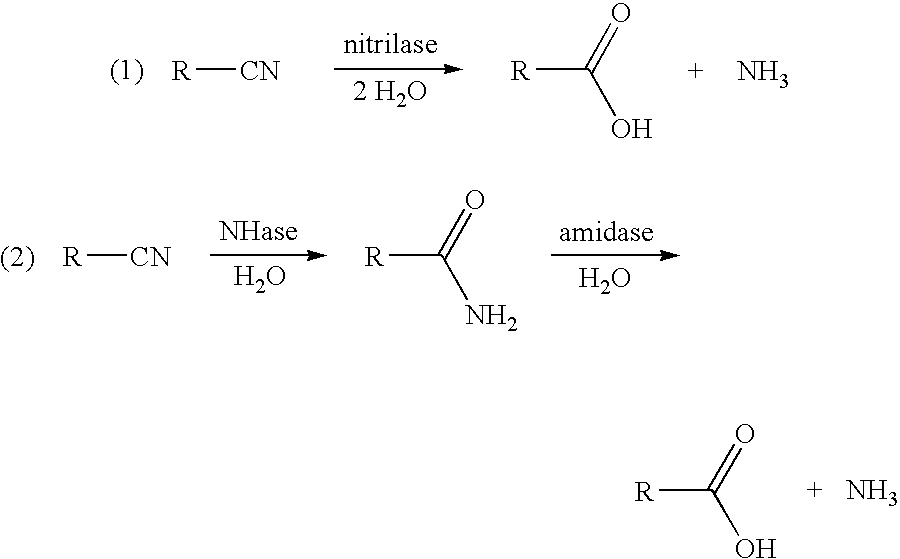3-Hydroxycarboxylic acid production and use in branched polymers
a technology of hydroxycarboxylic acid and branched polymer, which is applied in the direction of microorganisms, inks, bacteria based processes, etc., can solve the problems of large inorganic salts, large amount of inorganic salts, and complex separation of hydroxybutyric acid/hydroxyvaleric acid copolymers, etc., to achieve high yield
- Summary
- Abstract
- Description
- Claims
- Application Information
AI Technical Summary
Benefits of technology
Problems solved by technology
Method used
Image
Examples
examples
[0068]Materials and methods suitable for the maintenance and growth of bacterial cultures are well known in the art. Techniques suitable for use in the following examples may be found in Manual of Methods for General Bacteriology; Phillipp Gerhardt, R. G. E. Murray, Ralph N. Costilow, Eugene W. Nester, Willis A. Wood, Noel R. Krieg and G. Briggs Phillips, Eds.; American Society for Microbiology: Washington, D.C., (1994) or in Biotechnology: A Textbook of Industrial Microbiology, 2nd ed.; Thomas D. Brock, Sinauer Associates, Inc.: Sunderland, Mass., (1989). All reagents and materials used for the growth and maintenance of bacterial sells were obtained from Aldrich Chemicals (Milwaukee, Wis.), DIFCO Laboratories (Detroit, Mich.), GIBCO / BRL (Gaithersburg, Md.), or Sigma Chemical Company (St. Louis, Mo.) unless otherwise specified.
[0069]The meaning of abbreviations is as follows: “h” means hour(s), “min” means minute(s), “sec” means second(s), “d” means day(s), “μL” means microliters, “...
example 1
Hydrolysis of 3-Hydroxyvaleronitrile (0.448 M) with Comamonas testosteroni 22-1 Cells (Potassium Phosphate Buffer, pH 7.0)
[0071]A 10-mL reaction mixture containing 0.444 g (0.448 M) of 3-hydroxyvaleronitrile and 0.509 g wet cell weight (0.107 g dry cell weight) of Comamonas testosteroni 22-1 cells in aqueous potassium phosphate buffer (50 mM, pH 7.0) was mixed at 25° C. Samples (0.100 mL) were mixed with 0.100 mL of distilled, deionized water, then the diluted sample was mixed with 0.200 mL of aqueous 0.200 M sodium butyrate (HPLC external standard) and 0.015 mL of 6 N HCl, centrifuged, and the supernatant analyzed by HPLC. After 2.0 h, the conversion of 3-hydroxyvaleronitrile was 100 %, and the yield of 3-hydroxyvaleric acid was 100%.
example 2
Hydrolysis of 3-Hydroxyvaleronitrile (0.400 M) with Comamonas testosteroni 22-1 Cells (Bis-Tris Buffer, pH 6.0)
[0072]A 10-mL reaction mixture containing 0.397 g (0.400 M) of 3-hydroxyvaleronitrile and 0.257 g wet cell weight (0.0542 g dry cell weight) of Comamonas testosteroni 22-1 cells in aqueous Bis-Tris buffer (50 mM, pH 6.0) was mixed at 25° C. Samples (0.100 mL) were mixed with 0.100 mL of distilled, deionized water, then the diluted sample was mixed with 0.200 mL of aqueous 0.200 M sodium butyrate (HPLC external standard) and 0.015 mL of 6 N HCl, centrifuged, and the supernatant analyzed by HPLC. After 72.0 h, the conversion of 3-hydroxyvaleronitrile was 100%, and the yield of 3-hydroxyvaleric acid was 100%.
PUM
 Login to View More
Login to View More Abstract
Description
Claims
Application Information
 Login to View More
Login to View More - R&D
- Intellectual Property
- Life Sciences
- Materials
- Tech Scout
- Unparalleled Data Quality
- Higher Quality Content
- 60% Fewer Hallucinations
Browse by: Latest US Patents, China's latest patents, Technical Efficacy Thesaurus, Application Domain, Technology Topic, Popular Technical Reports.
© 2025 PatSnap. All rights reserved.Legal|Privacy policy|Modern Slavery Act Transparency Statement|Sitemap|About US| Contact US: help@patsnap.com

